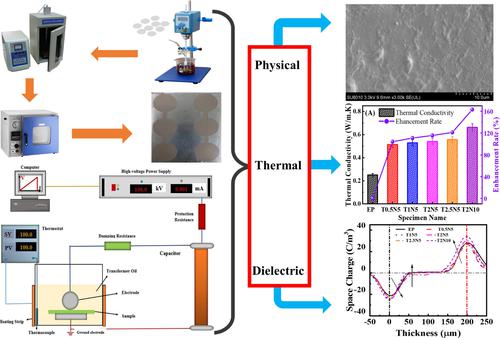当前位置:
X-MOL 学术
›
Polym. Compos.
›
论文详情
Our official English website, www.x-mol.net, welcomes your feedback! (Note: you will need to create a separate account there.)
Synergistic effect of positive temperature coefficient and thermally conductive micro‐nano fillers on electrical and thermal properties of epoxy resin
Polymer Composites ( IF 5.2 ) Pub Date : 2024-03-23 , DOI: 10.1002/pc.28362 Taqi ur Rahman 1 , Xiangrong Chen 1 , Tianyin Zhang 1 , Qilong Wang 1 , Kai Yin 1 , Muhammad Awais 2 , Ashish Paramane 3
T g ) of EP composites were measured. Results indicate that, below curie temperature, the EP composites containing 0.5 and 1 wt% of BST and 5 wt% of h‐BN have superior electrical resistivity, breakdown strength, and thermal conductivity. However, above curie temperature, the EP composites containing 2 and 2.5 wt% of BST and 5 wt% of h‐BN have superior insulation properties than the pure EP and other composites. While the thermal properties of EP improve with an increase in h‐BN loading to 10 wt%, its dielectric properties are slightly compromised due to the presence of tiny defects in the composite material. It is hypothesized that the BST‐60 suppresses the negative temperature coefficient effect (NTC) of EP by regulating the electrical resistivity above the curie point, whereas nano h‐BN enhances the thermal conductivity of EP by constructing a heat dissipation path. The proposed mechanism for charge dynamics along with heat conduction‐dissipation explains the fillers' behavior at different temperatures.Highlights Analysis of epoxy composites with polydopamine‐modified BST and h‐BN fillers. PTC fillers are used to mitigate the negative temperature effect of epoxy. Optimal fillers wt% improves dielectric and thermal properties. This study shows that optimized epoxy composites can be used for packaging.
中文翻译:

正温度系数与导热微纳填料对环氧树脂电热性能的协同作用
本研究研究了正温度系数(PTC)填料,即钛酸锶钡(BST-60)和纳米六方氮化硼(h-BN)填料对环氧树脂(EP)的热和介电绝缘性能的影响。电阻率、直流击穿强度、空间电荷、热导率、热重分析和玻璃化转变温度(时间 G )的EP复合材料进行了测量。结果表明,在居里温度以下,含有 0.5 和 1 wt% BST 和 5 wt% h-BN 的 EP 复合材料具有优异的电阻率、击穿强度和导热率。然而,在居里温度以上,含有 2 wt% 和 2.5 wt% BST 以及 5 wt% h-BN 的 EP 复合材料比纯 EP 和其他复合材料具有更优异的绝缘性能。虽然 EP 的热性能随着 h-BN 负载量增加到 10 wt% 而得到改善,但由于复合材料中存在微小缺陷,其介电性能略有下降。假设BST-60通过调节居里点以上的电阻率来抑制EP的负温度系数效应(NTC),而纳米h-BN则通过构建散热路径来增强EP的导热率。所提出的电荷动力学和热传导耗散机制解释了填料在不同温度下的行为。亮点 聚多巴胺改性 BST 和 h-BN 填料环氧复合材料的分析。 PTC 填料用于减轻环氧树脂的负面温度效应。 最佳填料重量百分比可提高介电和热性能。 这项研究表明,优化的环氧复合材料可用于包装。
更新日期:2024-03-23
Polymer Composites ( IF 5.2 ) Pub Date : 2024-03-23 , DOI: 10.1002/pc.28362 Taqi ur Rahman 1 , Xiangrong Chen 1 , Tianyin Zhang 1 , Qilong Wang 1 , Kai Yin 1 , Muhammad Awais 2 , Ashish Paramane 3
Affiliation

|
中文翻译:

正温度系数与导热微纳填料对环氧树脂电热性能的协同作用



























 京公网安备 11010802027423号
京公网安备 11010802027423号